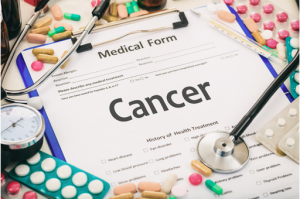
Cancer Insurance
 It has been reported that 39%-50% of men and 33%-38% of women will develop some form of cancer, and many of these may not become critical illnesses. Cancer insurance is a form of critical illness insurance that only covers malignant disease and therefore can be somewhat inexpensive compared to policies covering multiple illnesses. There may be some differences because of the focus on a single disease.
It has been reported that 39%-50% of men and 33%-38% of women will develop some form of cancer, and many of these may not become critical illnesses. Cancer insurance is a form of critical illness insurance that only covers malignant disease and therefore can be somewhat inexpensive compared to policies covering multiple illnesses. There may be some differences because of the focus on a single disease.
- The major difference is cancer insurance is more likely to use an expense incurred or indemnity format rather than the lump sum method more common with critical illness insurance.
- Expense-incurred policies pay out a percentage of expenses incurred, up to policy limits including copays, coinsurance, and drugs or treatments your traditional health insurance doesn’t cover.
- Indemnity policies cover expenses for approved treatments, up to a set limit, which may be lower than the actual costs of care.
- Lump sum policies pay a fixed amount of money after a cancer diagnosis which you can use for any expenses.
- Policies often have wellness benefits and will cover or help pay for cancer screenings.
 The nature of cancer and cancer treatment may make it the best candidate for an insurance policy to pay for costs not covered by your existing health insurance.
The nature of cancer and cancer treatment may make it the best candidate for an insurance policy to pay for costs not covered by your existing health insurance.
- Much of the management for malignant disease is done on an out-patient basis.
- Due to the cost, nature, and duration of treatment, you are much more likely to encounter high healthcare costs when diagnosed with a life-threatening cancer than with almost any other critical illness. It has been reported that 4% of the cost for cancer is out-of-pocket. Although this seems like a small percentage, the overall cost of cancer treatment is very high.
- Most cancer drugs and other treatments are very expensive, require skilled medical personnel to administer, and are usually given in multiple courses over a prolonged period of time.
- These treatment courses can be very debilitating, difficult to recover from, and require home health care.
- Many of the treatments have significant side-effects, some of which may be permanent.
- Multiple blood transfusions may be required.
- Specialized isolation procedures may be needed if your immune system is significantly compromised, especially during the COVID-19 pandemic.
- Treatments must be monitored closely with many tests and procedures.
- Many cancers require treatment at a speciality hospital/clinic.
- Most cancer treatment centers will be out of your network and are more expensive than community centers.
- You may need to travel long distances and/or require assistance with transportation.
- You or your family may need lodging near the center for the duration of the treatment course.
- You will likely be spending money eating meals away from home.
Cancer insurance must be purchased before you get sick, although you will not need a medical exam in order to obtain a cancer insurance policy. You may want to consider cancer insurance if you have a higher risk of developing cancer such as a family history of cancer, smoking history, or excessive sun exposure, especially if your health insurance coverage isn’t comprehensive.
Typically, you will not be able to obtain cancer insurance coverage if you currently have cancer or if you’ve been tested for, diagnosed with, or treated for cancer, have a pre-leukemic condition, or have been diagnosed with another condition with the potential for malignancy, such as HIV/AIDS, in the past five to ten years.
Additional Details About Cancer Insurance
 Cancer insurance policies can vary significantly in cost, coverage, and benefits. You may be able to customize your policy. If not, read the policy carefully to understand exactly the benefits being offered, what the requirements are for them, and when they would kick in. Ask about how much coverage you can get.
Cancer insurance policies can vary significantly in cost, coverage, and benefits. You may be able to customize your policy. If not, read the policy carefully to understand exactly the benefits being offered, what the requirements are for them, and when they would kick in. Ask about how much coverage you can get.
There are multiple details to look at and consider.
- How much it will cost. The older you are, the more likely it is you’ll develop cancer, so cancer insurance premiums will be more expensive as you get older when you apply for it. The more comprehensive your coverage, the more your premiums will be.
- Look for or specify the types of cancer covered as some policies may specifically exclude coverage for certain cancers.
- The characteristics of the cancer that are needed to qualify for the benefit. Many policies will not pay benefits unless the cancer has spread. Other characteristics may include how malignant a tumor is.
- Determine whether or not the policy only pays benefits if you are hospitalized. Since hospitals can be a dangerous place for those with a poor immune system, a major goal in oncology is to increase the availability of outpatient care. With this trend, it may be best to opt for a policy that provides benefits for outpatient treatment to avoid the high costs if your policy only pays benefits if you are hospitalized.
- Check the specifics of what the benefits can be used for, which may include:
- Hospital room and board;
- Treatment by a legally qualified physician;
- Private duty nursing care if required during your hospital stay;
- Surgery and anesthesia;
- X-ray, radiation therapy, chemotherapy, and other therapies used for treatment;
- Licensed or professional ambulance service to and from the hospital;
- Blood and blood plasma for transfusions;
- Prescription drugs and medicines recognized by the Food and Drug Administration as medically effective if administered during a hospital confinement; and/or
- Non-medical expenses such as child care, dietary assistance, travel, and lodging when treatment is far away from home.

- Be aware of the limitations on total and individual benefits.
- Limitations in dollar amounts or percentages could leave you with high costs. Limitations on procedure costs will be a problem if your form of cancer is treated primarily by such a procedure. If daily hospital costs are much higher than the benefit, you are responsible for paying anything your health insurance does not cover.
- Many policies specify how much it will pay for individual services, such as $1,500 for surgery costs, $1,000 for radiation therapy, or $50-$100 for each day in the hospital. This is called an indemnity policy, where the amount paid for covered treatments is not related to the actual cost.
- Other policies cover a specific percentage of the costs for treatments up to the benefit or policy’s maximum amount called an expense incurred policy. Most expense incurred policies require you to pay out-of-pocket and get reimbursed by your insurer. Expense incurred policies are more likely to be limited to inpatient care.
- What the policy total benefit limits are. Make sure it is an amount that will make a reasonable reduction in your out of pocket expenses. You will need to know what your health insurance will cover to estimate this.
- If the policy pays the benefit as a lump sum at the time of the initial diagnosis, make sure you know the stage of cancer is consistent with the terms of the policy. Lump sum policies are more expensive than indemnity plans or expense-incurred plans, but are more flexible in how you’re able to use the benefits. You can use the benefits for nonmedical costs such as transportation, expenses of daily living, and/or lodging.
Other questions to consider:
- What is the waiting period between buying the policy and ability to use it? This is usually 30 days.
- How long do you need to have the illness before the benefits begin?
- What are the effects a pre-existing condition would have on the policy?
- Can the policy cover secondary illnesses caused by the cancer or its treatment?
- What is required to verify your diagnosis?
- Can you renew the policy if it has expired?
- Are there better alternatives, such as critical illness insurance or Medigap/MedSup if you have Medicare?
